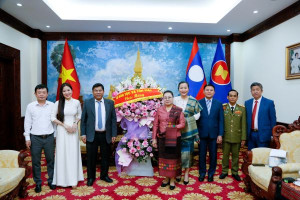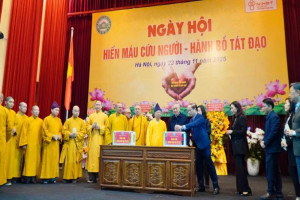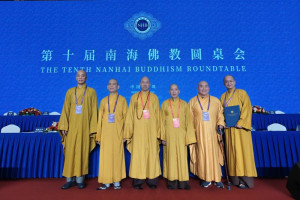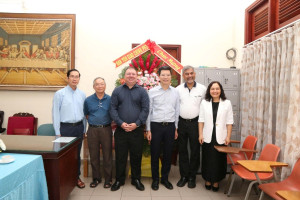
President Trần Đại Quang beat a gong to launch the annual spring festival at the Culture-Tourism Village of Vietnamese Ethnic Groups in Hà Nội’s outlying district of Sơn Tây on February 24 (the ninth day of the Lunar New Year).
Attending the event were 200 delegates who are village patriarchs and chiefs, intellectuals and artisans representing 21 ethnic groups from 14 cities and provinces nationwide.
In his speech, the President lauded the Ministry of Culture, Sports and Tourism, the management board of the village and ethnic groups living in the village for contributing to the preservation and development of the traditional Vietnamese culture, saying that the festival has attracted tens of thousands of visitors over the past years.
He wished that village chiefs, artisans, religious dignitaries and prestigious people representing ethnic groups and localities would actively work to raise public awareness of the Party and State policies and guidelines to contribute to national development.
The State leader asked ministries, agencies and mass organisations from the central to grassroots level to assist ethnic minority groups in socio-economic development, education, culture and health care.
On the occasion, he planted a tree in Mường ethnic minority village and launched the Gầu Tào festival of the Mông ethnic minority group in the northern mountainous province of Hà Giang.
The spring festival at the ethnic cultural village will feature a wide range of activities, spotlighting the traditions, customs and spring festivals of 54 ethnic groups across the country.
Also on the same day, the President offered incense and released birds at a spring ceremony held at the Thăng Long Imperial Citadel’s Kính Thiên Palace in central Hà Nội.
The incense offering ceremony in early spring aims to commemorate ancestral kings and those who have made contribution to the nation as well as pray for the country’s prosperity.
Various traditional rituals were held during the ceremony, including palanquin procession staged by more than 300 people, a dragon dance, drum performance and folk music performance.
The incense offering ceremony is part of a series of activities celebrating the Lunar New Year organised from the 23rd day of the twelfth month of the previous lunar year to the 15th day of the first month of the new lunar year by the Thăng Long-Hà Nội heritage conservation centre.
The Imperial Citadel of Thăng Long was built in the 11th century during the Lý dynasty to mark the independence of Đại Việt, the former name of Việt Nam. The central sector of the citadel was listed as a UNESCO’s World Heritage Site in July 2010.
Source: vietnamnews.vn




